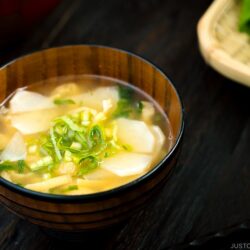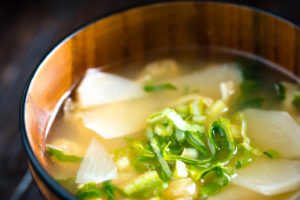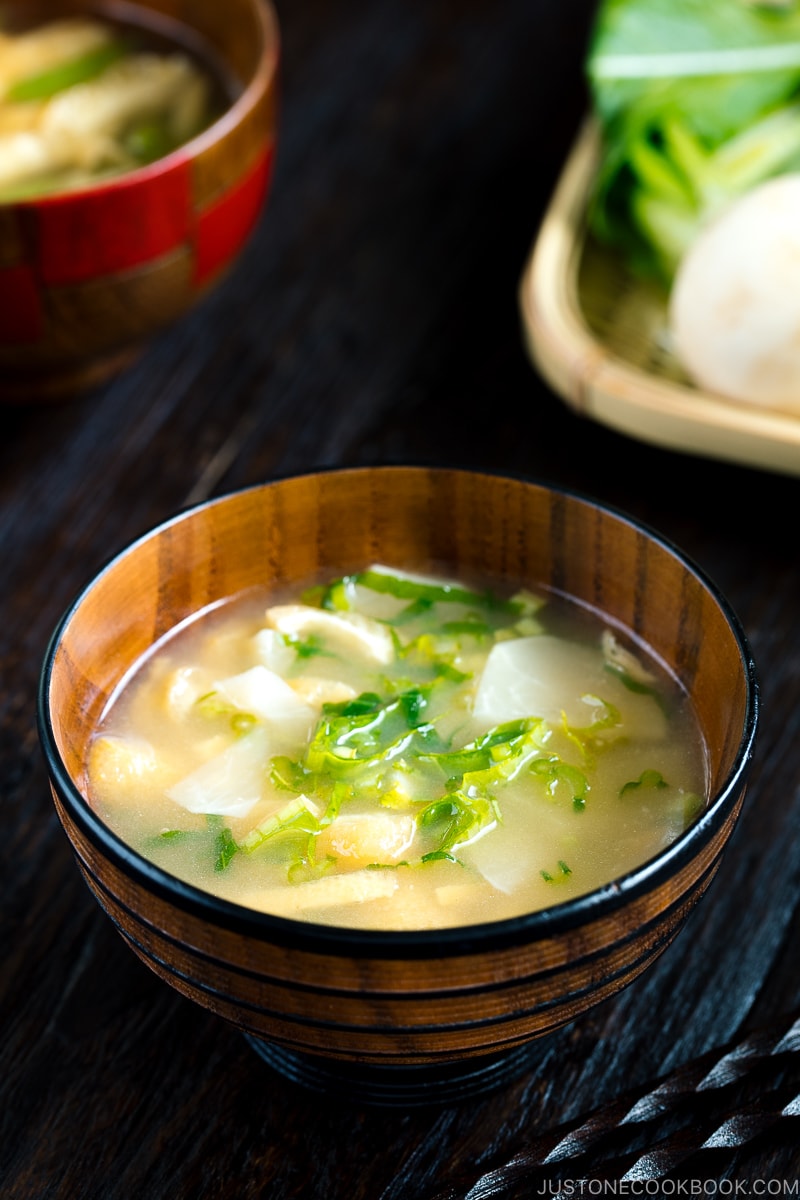
Miso soup is a staple dish for the Japanese. It’s basically on the table at least once a day. Whenever a bowl of steamed rice is served, you can expect that miso soup will be served as well (not prior to mealtime like a Western course meal). Miso soup and rice are like husband and wife – always side by side. And here’s the important part: miso soup in Japan is not just tofu, wakame seaweed, and green onion. Every day the ingredients vary.
Today I’ll show you 3 kinds of Vegetable Miso Soup (野菜のお味噌汁) that you can easily make at home!
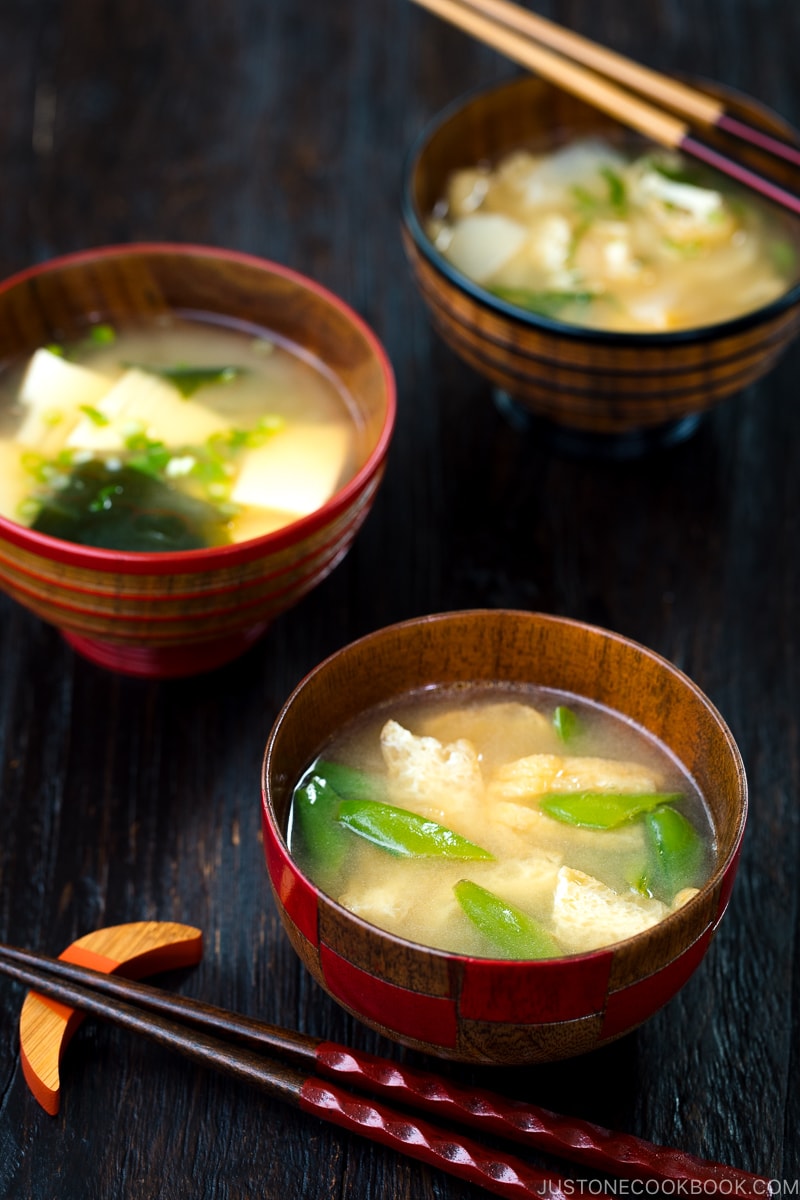
Use Hikari Miso® Organic Miso
Wondering what it takes to make simple yet authentic miso soup? There are usually 3 steps:
- Make dashi (Japanese soup stock).
- Add ingredients to dashi and cook till they are ready.
- Add miso to taste, and serve!
Today, however, we will skip “Step 1: Make dashi.” Are we really skipping the most important part of the process?! Is the miso soup going to taste delicious still?
Well, yes! Let me introduce to you – Organic Miso (Dashi Miso) by Hikari Miso.

What makes this possible is that katsuo (bonito) and kombu (kelp) dashi are already included in Organic Miso (Dashi Miso) by Hikari Miso. All you need to do is to dissolve the miso paste right before serving the soup. How easy is that?
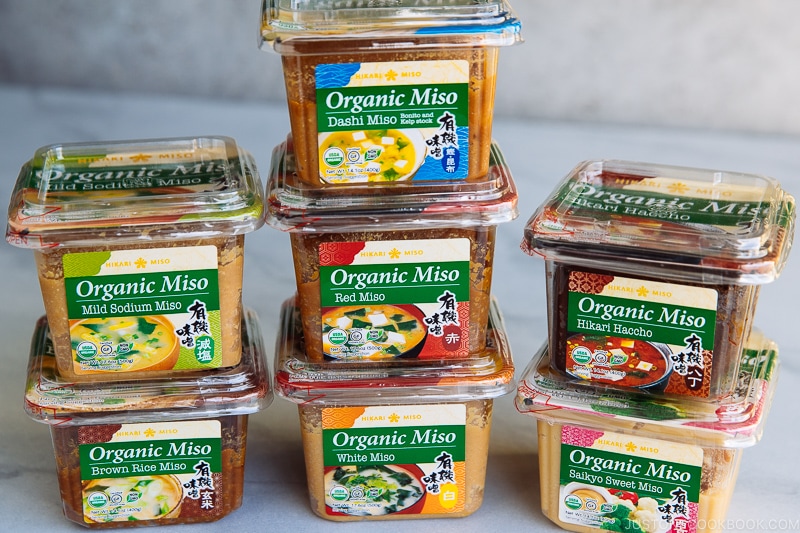
Click here to read more about miso.
3 Vegetable Miso Soups to Make in the Season
With the arrival of spring, I want to take advantage of the early harvest of spring vegetables by incorporating them in the miso soups today. Here are 3 delicious vegetable miso soups to welcome the season:
1. Snap Peas and Aburaage (Deep-Fried Tofu Pouch)
When we visited NYC last month, we stayed at our close friend’s house. Our friend who was hosting asked me if I’ve tried miso soup with snap peas. I said no, and she made one for me. The flavor was bright and delicious. When I came home, I decided to combine snap peas with aburaage in my miso soup. The crisp texture of snap peas and the cushiony tofu pouch, it really couldn’t be more enjoyable.
2. Bamboo Shoot, Wakame Seaweed, and Green Onion
Bamboo shoot is one of the classic spring ingredients in Japan. Wakame seaweed always goes well with bamboo shoot. Where do we get a bamboo shoot? Most Japanese and Asian grocery stores carry pre-boiled bamboo shoots in a package. It’s easy and quick to cook.
3. Japanese Turnip, Turnip Leaves, and Aburaage
I relish the mild sweet taste and crunchy texture of Japanese turnips. We enjoy the leafy greens of the turnips too. One of my friends told me that American farmers’ markets carry Japanese turnips so be sure to check out your local farmer’s markets. Whole Foods or some upscale grocery stores may also carry these popular Japanese turnips. If not, you may have better luck at Japanese grocery stores.
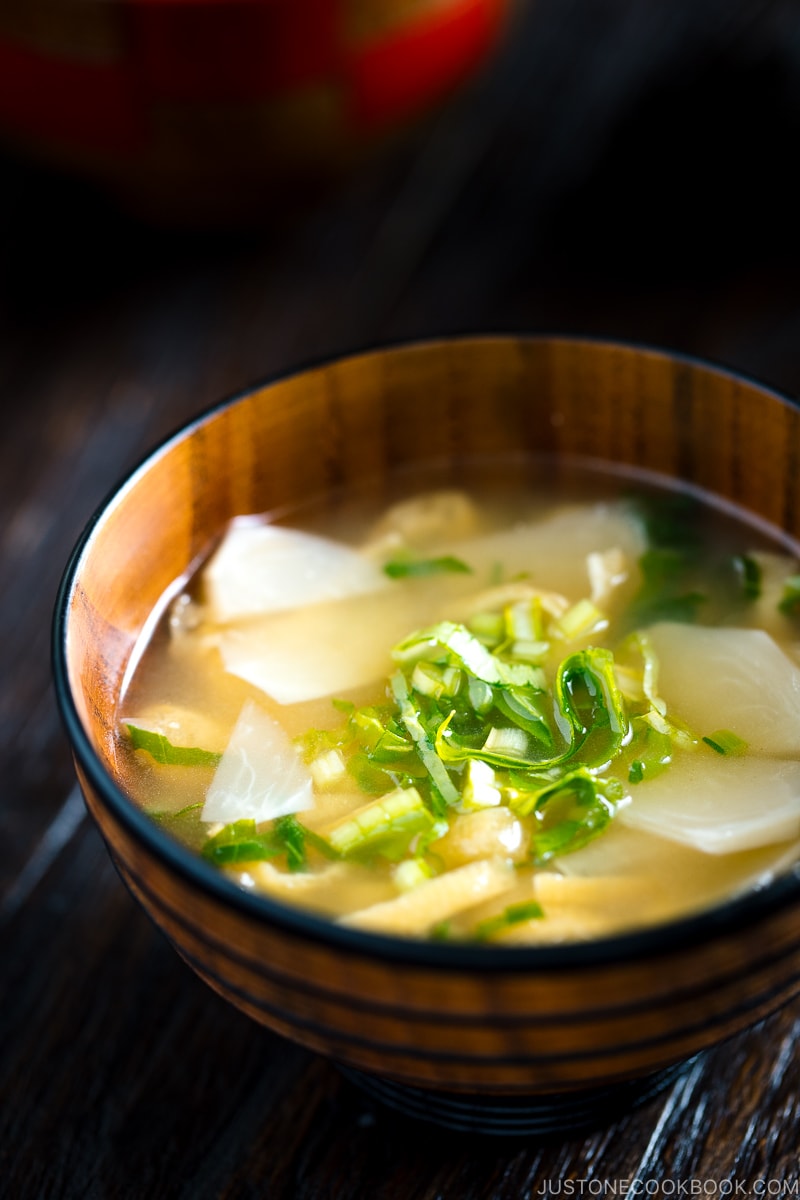
How about Vegetarian/Vegan Miso Soups?
This Organic Dashi Miso by Hikari Miso contains katsuobushi (dried bonito flakes) which is made out of dried and fermented tuna. It is not vegetarian-friendly.
Don’t worry, if you are a vegetarian or vegan, make Vegan Dashi and use regular organic miso that does not contain dashi!
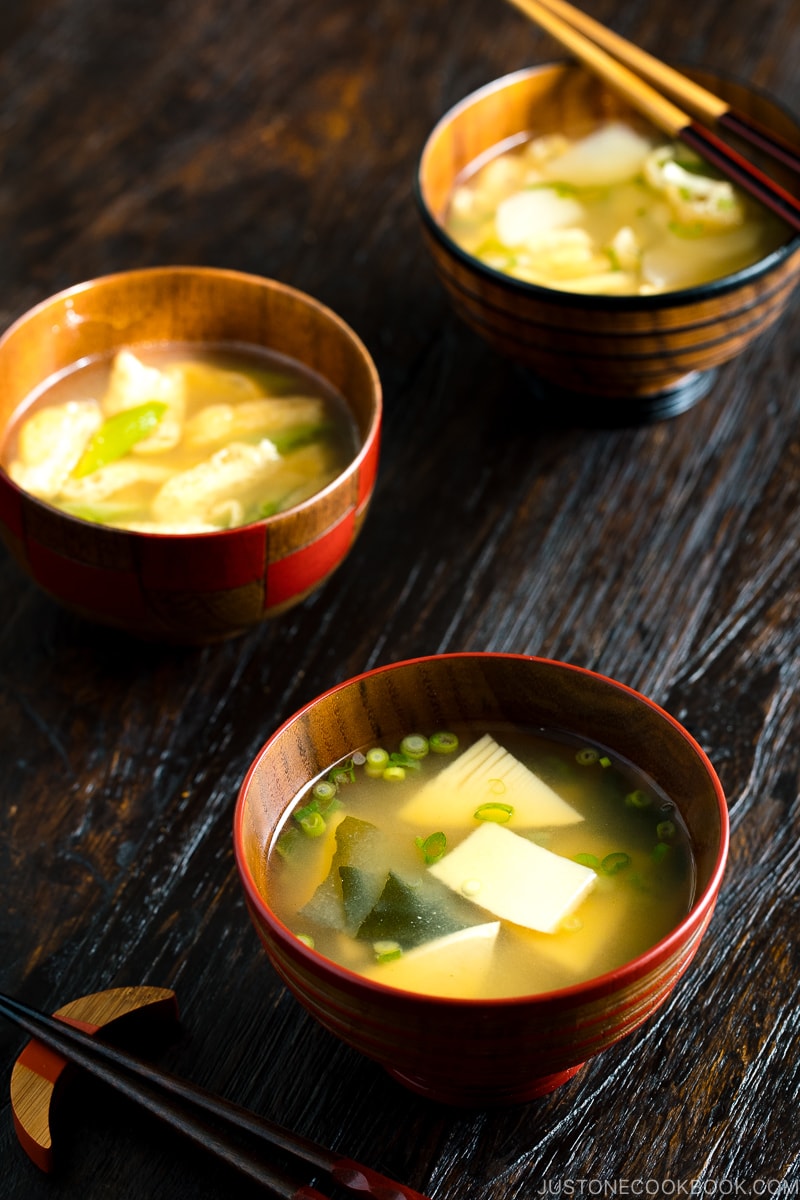
3 Rules of Thumb About Miso Soups
1. Cook root vegetables first, then add softer ingredients
Because stir-frying requires cooking oil, we do not stir fry vegetables for miso soup unless the meat is added, like Tonjiru (Pork Belly and Vegetable Miso Soup). Instead, we boil the root vegetables in the water and then add the softer ingredients and leafy greens at the later stage.
2. Add miso right before eating
Turn off the heat when you add miso. You always want to add miso last to keep the fragrance and taste.
3. Never let miso soup come to a rolling boil
Re-heating is okay, but be extra careful not to boil. Miso is a fermented soybean paste that contains live, active cultures of bacteria (like the good bacteria in yogurt). Boiling the miso soup will kill the probiotics in the miso.
Notes
- Tofu is edible right out of the package. Therefore, for miso soup, you will need to just heat up the tofu. There’s no need to “cook” the tofu.
- Wakame seaweed is still salty when you take it out from the package. You will need to first rehydrate it in the water and discard the salty water before putting the wakame into miso soup or straight into the miso soup bowl.
Follow these basics, you’d be ready to create irresistible miso soups any time of the year. Vegetable Miso Soup is one sure way to eat more greens and seasonal vegetables. As the season progresses, the ingredients change so you can never get tired of it.
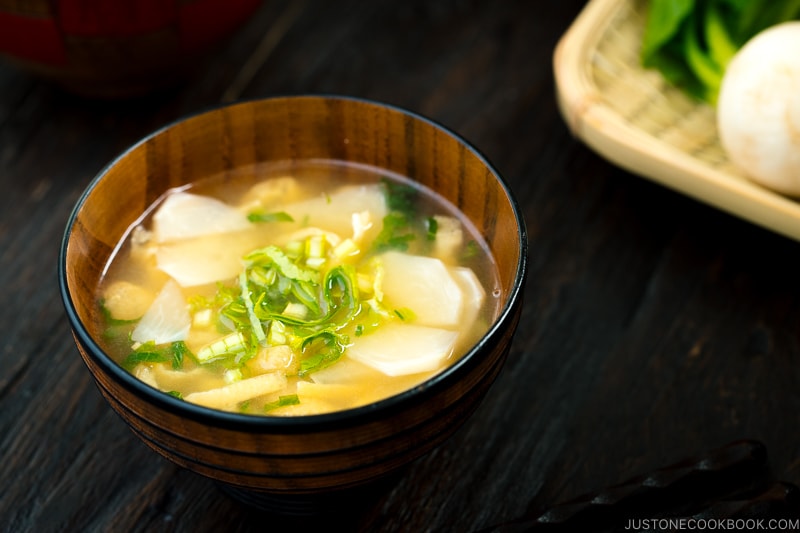
Wish to learn more about Japanese cooking? Sign up for our free newsletter to receive cooking tips & recipe updates! And stay in touch with me on Facebook, Pinterest, YouTube, and Instagram.
Vegetable Miso Soup
Ingredients
Basics Ingredients for 3 Kinds of Miso Soup Below
- 1½ cups water (for vegan/vegetarian, make Vegan Dashi and use regular miso)
- 2 Tbsp dashi-included miso (you can add up to ½ Tbsp more, to taste)
1) For the Japanese Turnip Miso Soup
- 1 Japanese turnip (kabu) (with leaves attached)
- ½ aburaage (deep-fried tofu pouch) (0.3 oz, 10 g)
2) For the Bamboo Shoot & Wakame Miso Soup
- 1 Tbsp dried wakame seaweed
- 1 green onion/scallion
- ¼ boiled bamboo shoot (1.8 oz, 50 g)
3) For the Snap Pea Miso Soup
- ½ piece aburaage (deep-fried tofu pouch) (0.3 oz, 10 g)
- 7 oz snap peas
Instructions
- Gather all the ingredients.
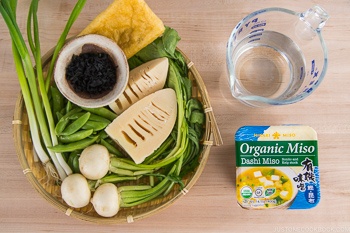
1) To Make the Japanese Turnip Miso Soup
- Cut off the ends of 1 Japanese turnip (kabu) and peel.

- Cut the turnip in half and thinly slice the halves.
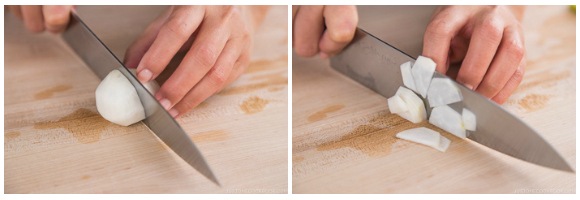
- To remove the oil from ½ aburaage (deep-fried tofu pouch), you can either pour boiling water over the tofu pouch in a sieve over the sink or have a quick blanch over the boiling water in a small pot for 15 seconds (flipping 1–2 times). Once that’s done, cut the aburaage in half widthwise, and cut thinly. Keep the other half for future use.

- In a small saucepan, add 1½ cups water, the sliced turnip, and the aburaage.
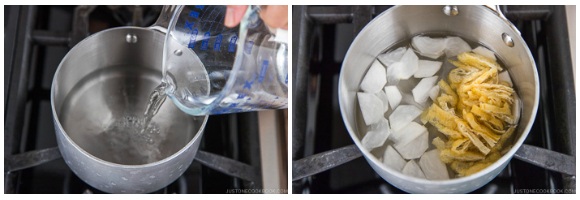
- Cover with the lid, but keep it slightly ajar to avoid boiling over. Bring it to a boil over medium heat. Once boiling, lower the heat to simmer and cook the turnip for 5–6 minutes, or until it’s transparent.

- If you wish to add the turnip leaves into the soup, quickly chop the green leafy part of the turnip. Add some into the soup and save the remaining greens. At this stage, make sure the soup is hot and you’re about to serve miso soup. What to do with the rest of the chopped leaves? Read the Notes for a quick, delicious recipe.
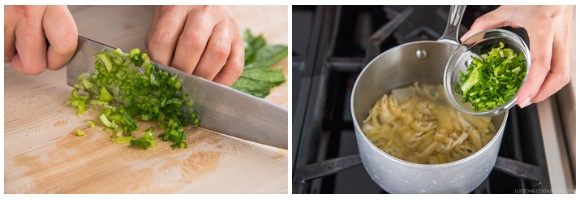
- Make sure the soup is hot as we will not reheat and turn off the heat. Add 2 Tbsp dashi-included miso into the ladle, NOT into the soup. Use a pair of chopsticks (or fork) to dissolve the miso completely in the ladle before releasing it into the soup.
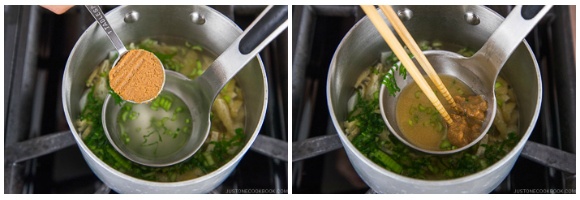
- ALWAYS taste the miso soup before adding more miso. Serve immediately. If you need to reheat the miso soup, make sure not to let it boil, once you see steam coming off, you can turn off the heat.
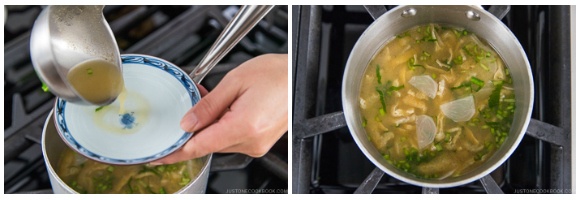
2) To Make the Bamboo Shoot & Wakame Miso Soup
- Soak 1 Tbsp dried wakame seaweed in water for 5 minutes. Drain, squeeze water out, and set aside.

- Cut 1 green onion/scallion thinly and set aside.
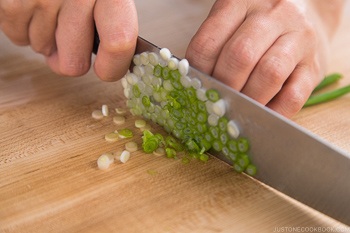
- Cut ¼ boiled bamboo shoot into small bite-size thin pieces.

- In a small saucepan, add 1½ cups water and the sliced bamboo shoots.
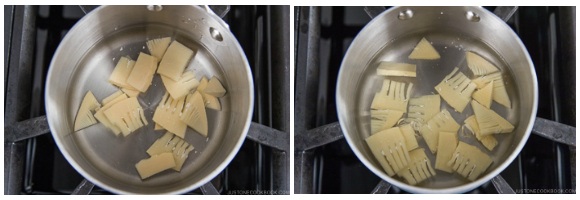
- Cover with the lid, but keep it slightly ajar to avoid boiling over. Bring it to a boil over medium heat. Once boiling, turn off the heat.

- Make sure the soup is hot at this stage as we will not reheat. Add 2 Tbsp dashi-included miso into the ladle, NOT into the soup. Use a pair of chopsticks (or fork) to dissolve the miso completely in the ladle before releasing it into the soup. ALWAYS taste the miso soup before adding more miso.
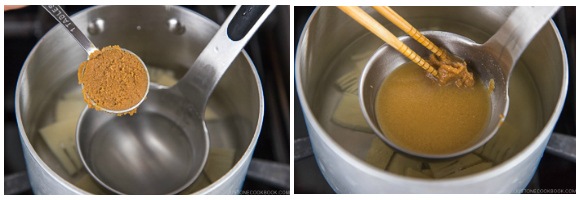
- Serve immediately. If you need to reheat the miso soup, make sure not to let it boil, once you see steam coming off, you can turn off the heat.
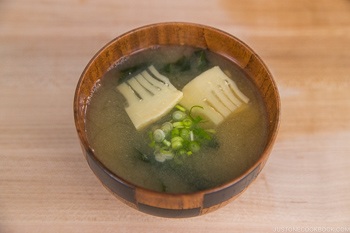
3) To Make the Snap Pea Miso Soup
- To remove the oil from ½ piece aburaage (deep-fried tofu pouch), you can either pour boiling water over the tofu pouch in a sieve over the sink or have a quick blanch over the boiling water in a small pot for 15 seconds (flipping 1–2 times). Once that’s done, cut the aburaage in half widthwise, and cut thinly. Keep the other half for future use.

- Pull off the tough string that runs along the length of each pod from 7 oz snap peas. Then cut in half diagonally.

- In a small saucepan, add 1½ cups water and the aburaage. Place the lid, keeping it slightly ajar to avoid boiling over. Bring it to a boil over medium heat, and once boiling, lower the heat to simmer.

- Add the snap peas and warm them for 2 minutes on a simmer (don’t overcook). Turn off the heat.
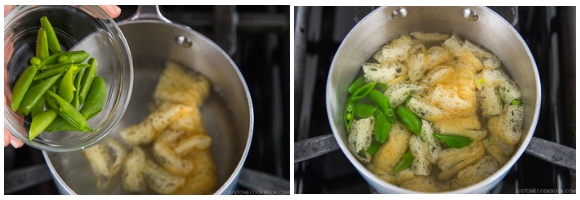
- Make sure the soup is hot at this stage as we will not reheat. Add 2 Tbsp dashi-included miso into the ladle, NOT into the soup. Use a pair of chopsticks (or fork) to dissolve the miso completely in the ladle before releasing into the soup. ALWAYS taste the miso soup before adding more miso. Serve immediately. If you need to reheat the miso soup, make sure not to let it boil, once you see steam coming off, you can turn off the heat.
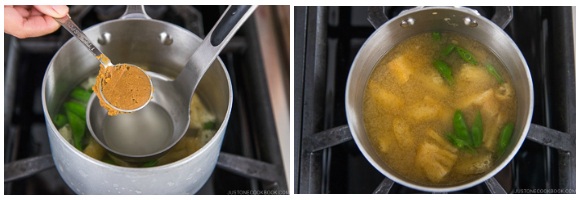
To Store
- You can keep the leftovers in an airtight container (or in a pot) and store in the refrigerator for up to 3 days.
Notes
- Miso: General guideline is 1 Tbsp (18 g) per ¾ cup (180 ml). Each miso paste has different salt content; therefore adjust the amount accordingly.
- Japanese turnip: Unlike the western turnip, the Japanese ones are milder and sweeter. You can replace it with other turnips, but the taste will be slightly different.
- Leftover turnip leaves: You can stir fry the rest of the chopped leaves in sesame oil and season with a little bit of mirin and soy sauce. Sprinkle sesame seeds and enjoy it with steamed rice.
Nutrition
Did you make this recipe?
Tag @justonecookbook on Instagram so we can see your delicious creation!


